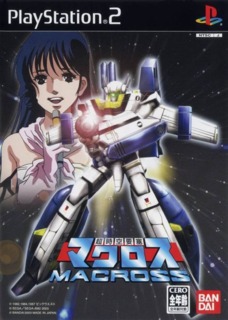Riding a Valkyrie fighter has never been this much fun.
- Arcade-style dogfights and battles sates the senses.
- Controls the Valkyrie fighter in Battloid and Gerwalk modes are forgiving.
- Lots of collectibles and extras.
Cons:
- Very short game; You can finish the story mode in a day.
- Japanese only; you need to import this game and own a Japanese PS2 to play.
- No online modes.
Verdict:
Macross video games may not have a long history, but hopefully Sega-AM2's Choujikuu Yousai Macross is a start of a new beginning for the franchise.
Original Review:
The Macross anime series is one of Japan's oldest pop culture franchises. The series spawned a number of toys, collectibles, soundtracks, comic books, and video games. However, anime-to-video game adaptations are usually about as hit-or-miss as movie-to-video game adaptations here in the U.S. Thankfully, Chou-jikuu Yousai Macross (or the more unwieldly translated, Super Dimension Fortress Macross) does not fall into that category.
The game is very simple, but a little difficult to get all the rankings and all the collectibles. You play the lead character, Ichijou Hikaru (Hikaru is his given name) who pilots the Valkyrie Fighter or VF-1 fighter under the wing of Roy Focker. You go through the first set of missions, which follows the Television-series timelime, followed by a second set, which follows the motion picture timeline. Much like in the series, you can switch between 3 different modes that the VF-1 is capable of: jet fighter, gerwalk and battloid. The jet fighter mode is just that, you soar through the skies and in space using infinite ammo on the machine gun and a finite number of heat-seaking missles. Gerwalk mode is half jet fighter, half robotic feet. You'll use this mode when you need to constantly evade enemies, while having your feet firmly on the ground. Battloid mode is the complete robot form. You'll need this form if you're battling on the ground and the need to take aim. Switching between these modes is as simple as pressing a button, which it is the case here. You will find that you will constantly change modes often in certain situations, which makes for some varied gameplay. However, the game eventually will feel repetitive, since all you do is aim and shoot.
As with most Japanese games, the graphics and sound in the game are bright but passable, though a little dated compared to Western games that are released at that time. It's what I call the "smoke and mirror" effect that Japanese games employ to make their games look good, but are actually using cheaper technology to save on cost in developing the game. Nevertheless, it works here and it's not half-bad.
There are only two knocks I have against this game. One, the game is Japan only, meaning you must have a Japanese PS2 and an extra $10-15 more than the average U.S. domestic or localized game to pay for admission. And two, the game is relatively short. You can extend the value of the game if you attempt to get all the collectibles, but even then you might get bored of going through the same missions over and over again.
Despite these quibbles, it is a solid game, and I think is worth the price of the admission just to play a good Macross game for once. But, for others who aren't into the genre, this game may not be worth it.

